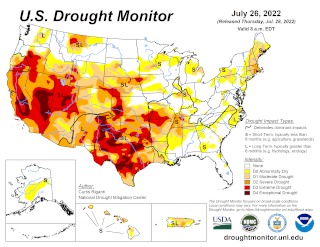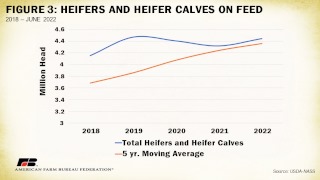By Bernt Nelson
Drought
Drought conditions, particularly in the West and Southern Plains, are causing problems for farmers and ranchers. Conditions are worsening. Pasture and range land conditions rated poor to very poor were reduced from 49% to 50% in the last week for 48 states. However, pasture and rangeland rated very poor increased to 27%, up 2% from last week. Figure 1 illustrates the change in pasture and rangeland conditions for selected states for the week ending July 31, 2022, compared to last week, last year, and July 2019. Eight states reported 50% or more pasture and rangeland as poor to very poor. Texas came in with 91% rated as poor or very poor, followed by Arkansas at 72%. The U.S. drought monitor in Figure 2 illustrates the level of drought these regions are currently experiencing. Drought is one of the reasons that more heifers are entering the slaughter pipeline.


Cattle Numbers
The inventory of all cattle and calves in the Unites States on July 1 was down 2% from a year ago, to 98.8 million head. Cattle inventory at the beginning of the year was also down 2%, to 93.8 million head. This shows that U.S. cattle numbers are on the decline.
On July 1, 2022, cattle on feed totaled 11.3 million head, slightly above July 1, 2021. Placements were 1.63 million head, 2% below this time in 2021. Marketings of fed cattle (the number sold for slaughter) in June 2022 were 2.06 million head, 2% above 2021. Steers and steer calves were down 1% from 2021, accounting for 61% of the total inventory.
Figure 3 illustrates the increase in heifer and heifer calves on feed compared to the five-year moving average.

The rise in the number of heifers entering feed lots is very important, because these females are the reproductive engine responsible for replacing the cattle inventory that is lost to slaughter, death and other disappearance. When drought causes pasture conditions to decline, heifers that would typically be kept for replacements are instead being placed into feed lots. More heifers being slaughtered means fewer heifers available to produce calves. Fewer calves mean a smaller cattle supply in 2023.
Beef Prices & Cold Storage
On the consumer side, many are asking if tighter cattle supplies will mean paying more for beef at the grocery store. There is some delay from the time supply changes occur to when the consumer sees a change in retail prices. It takes 18-22 months from the time a calf is born until it reaches market weight. The animal is then processed and hung at 38 degrees Fahrenheit for at least 10 days before it is processed into what is called boxed beef. Boxed beef either enters the retail market or enters cold storage.
Total red meat in cold storage dropped 1% between May and June 2022, but is 24% higher than this time in 2021. Total pounds of beef in cold storage dropped 2% between May and June but was 29% higher than this time in 2021. Please see our other Market Intel for more information on cold storage.
Click here to see more...